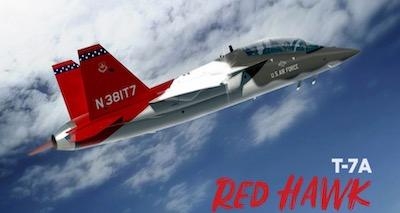Sun, May 07, 2023
Expected Release Date Slides by 3 Years After Continued Ejection Seat Problems
The T-7A Red Hawk jet trainer won't be expected to reach initial operational capability until spring of 2027 according to an Air Force release.

The aircraft was supposed to be the next-generation replacement for the long-in-the-tooth, but venerable, T-38 Talon. The T-X, as it was initially known, was hurriedly propositioned to replace the aged and increasingly weary Talons after more than 6 decades of service. When slated for adoption, the Air Force planned to have the Red Hawk in service in FY 2020. Budgets and politics got in the way, and its priority slid throughout the twenty-teens, culminating in the first production aircraft rolling off the line in late April of 2022.
No new aircraft is without its teething issues, and the T-7 appears to be no exception. Problems with the escape system and ejection process continued to grate against deadlines, with first deliveries from Boeing expected to take place sometime in December 2025. USAF acquisition chief Andrew Hunter told reporters that the T-7 isn't slated to hit IOC until 2027, with current ground evaluation focused on sled-testing before moving on to taxi tests. Despite watching what was once supposed to be a fairly high priority program for the Air Force - remember, airmen have died from fatigue failures in the T-38 Talon - the program continues to move at a meandering government pace. Perhaps most at fault is Boeing, however, working with Saab on their joint T-X program.
Currently, the bugbear of the T-7 lies in its problems with allowing a safe escape from an imperiled aircraft. While it was designed to accommodate a wider range of body types and pilot demographics, ejecting pilots risk high-speed concussions and a perilous amount of acceleration on ignition, all capped off by an equally dangerous deceleration when their parachute deploys. Once ready, the service expects to replace more than 500 of its T-38s with more than 350 T-7s - whenever it's ready, at least.
More News
Airport Marking Aids Markings used on runway and taxiway surfaces to identify a specific runway, a runway threshold, a centerline, a hold line, etc. A runway should be marked in ac>[...]
"It is extremely difficult, if not impossible, for manned aircraft to see a drone while conducting crop-enhancing and other aerial applications at low altitudes and high speeds. We>[...]
Aero Linx: The Skyhawk Association The Skyhawk Association is a non-profit organization founded by former Skyhawk Pilots which is open to anyone with an affinity for the A-4 Skyhaw>[...]
“The T-54A benefits from an active Beechcraft King Air assembly line in Wichita, Kansas, where all required METS avionics and interior modifications are installed on the line>[...]
Aero Linx: Aerostar Owners Association The Association offers the Aerostar Owner a unique opportunity to tap an invaluable source of information concerning the care and feeding of >[...]
 ANN's Daily Aero-Term (04.28.24): Airport Marking Aids
ANN's Daily Aero-Term (04.28.24): Airport Marking Aids Aero-News: Quote of the Day (04.28.24)
Aero-News: Quote of the Day (04.28.24) ANN's Daily Aero-Linx (04.28.24)
ANN's Daily Aero-Linx (04.28.24) Aero-News: Quote of the Day (04.29.24)
Aero-News: Quote of the Day (04.29.24) ANN's Daily Aero-Linx (04.29.24)
ANN's Daily Aero-Linx (04.29.24)



